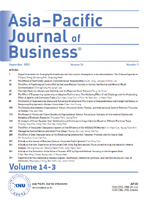Forward Premium Puzzle and Long Memory Property at the Very Short Time Horizon: Fractional Integrated Approach
- The Institute of Management and Economy Research
- 아태비즈니스연구
- Vol.16 No.2
-
2025.06137 - 153 (17 pages)
-
DOI : 10.32599/apjb.16.2.202506.137
- 6

Purpose - The purpose of this paper is to investigate the forward premium puzzle at the very short time horizon in terms of the fractional integration focusing on the long memory property in the forward premium. Design/methodology/approach - This paper checks the long memory property in the forward premium at the 1-day maturity time by using the Local Whittle method to examine the “unbalanced” regression specification for UIP between the spot returns and the forward premium in terms of the fractional integration. And, this paper estimate the more “balanced” UIP regression specification with including the filtered forward premium after eliminating the long memory property from the forward premium by the fractionally integrated ARFIMA model. Findings - This paper first finds that the forward premium at the very short time horizon contain very strong long memory property and follow nonstationary I(d) process while the spot returns follow the stationary I(0) process so that the puzzle still exist even at the very short time horizon because the standard regression specification of the UIP is unbalanced in terms of the fractional integration. And, this paper presents that if the long memory property in the forward premium is filtered and the regression specification become the more balanced, the puzzle at the very short time horizon may not be so serious as before. Research implications or Originality - While the focus of this paper is on the foreign exchange markets, similar problems can arise in the other financial markets. So, the approach in this paper may be useful to explain the unbalanced regression results in the financial markets.
Ⅰ. Introduction
Ⅱ. Theoretical Backgrounds for Forward Premium Puzzle
Ⅲ. Forward Premium Puzzle with Significant Long Memory Property
Ⅳ. Forward Premium Puzzle with Insignificant Long Memory Property
Ⅴ. Conclusion
References
(0)
(0)